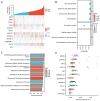Prognostic significance of elevated expression levels of protein phosphatase 1 regulatory subunit 3G in thyroid carcinoma
- PMID: 39664612
- PMCID: PMC11632660
- DOI: 10.3892/ol.2024.14828
Prognostic significance of elevated expression levels of protein phosphatase 1 regulatory subunit 3G in thyroid carcinoma
Abstract
The prognosis of the poorly differentiated subtype of thyroid carcinoma (THCA) is less favorable due to its aggressive nature, which also increases the likelihood of metastasis to distant organs. The present study aimed to assess the potential application of protein phosphatase 1 regulatory subunit 3G (PPP1R3G) as a molecular biomarker for early identification and prognosis prediction in THCA. The Cancer Genome Atlas (TCGA) database was used to identify genes associated with prognosis and differentially expressed genes in THCA. Additionally, TCGA data were used to analyze the differential expression of the PPP1R3G gene in THCA tissues compared with that in normal tissues. Immunohistochemistry was used for further confirmation of these findings. A prognostic significance analysis of the PPP1R3G gene was performed in patients diagnosed with THCA using Cox regression models. Both univariate and multivariate approaches were used, incorporating clinical information obtained from the patients. Moreover, to gain insights into the molecular mechanisms underlying the regulatory role of the PPP1R3G gene in THCA, a functional enrichment analysis performed. An assessment of the levels of immune cell infiltration in patients with THCA was also performed and their correlation with the expression level of PPP1R3G gene was assessed. The mRNA and protein levels of PPP1R3G were revealed to be higher in THCA tissues compared with that of noncancerous thyroid tissues. Moreover, there were significant associations between the expression of PPP1R3G in THCA and factors such as sex, histological type, pathological node stage, pathological stage, extrathyroidal extension and overall survival (OS). Univariate and multivariate Cox regression analyses revealed that the independent prognostic value of PPP1R3G could be used to predict the OS of patients with THCA. The outcomes obtained from functional enrichment analysis indicated a potential involvement of PPP1R3G in regulation of biological processes such as keratinization, and differentiation of keratinocytes and epidermal cells. Additionally, an association was demonstrated between the expression levels of PPP1R3G gene and several immune cells present within the tumor microenvironment of the thyroid. In conclusion, PPP1R3G has the potential to serve as a prognostic indicator for patients diagnosed with THCA, and may also be considered a promising target for therapeutic interventions in THCA.
Keywords: bioinformatics analysis; protein phosphatase 1 regulatory subunit 3G; thyroid cancer.
Copyright: © 2024 Dai et al.
Conflict of interest statement
The authors declare that they have no competing interests.
Figures







Similar articles
-
Bioinformatics analysis for the identification of Sprouty-related EVH1 domain-containing protein 3 expression and its clinical significance in thyroid carcinoma.Sci Rep. 2024 Feb 24;14(1):4549. doi: 10.1038/s41598-024-55187-2. Sci Rep. 2024. PMID: 38402263 Free PMC article.
-
Protein phosphatase 1 regulatory subunit 3G (PPP1R3G) correlates with poor prognosis and immune infiltration in lung adenocarcinoma.Bioengineered. 2021 Dec;12(1):8336-8346. doi: 10.1080/21655979.2021.1985817. Bioengineered. 2021. PMID: 34592886 Free PMC article.
-
Identification of disulfidptosis-associated genes and characterization of immune cell infiltration in thyroid carcinoma.Aging (Albany NY). 2024 Jun 4;16(11):9753-9783. doi: 10.18632/aging.205897. Epub 2024 Jun 4. Aging (Albany NY). 2024. PMID: 38836761 Free PMC article.
-
The expression of CCL17 and potential prognostic value on tumor immunity in thyroid carcinoma based on bioinformatics analysis.Sci Rep. 2024 Dec 30;14(1):31580. doi: 10.1038/s41598-024-75750-1. Sci Rep. 2024. PMID: 39738081 Free PMC article.
-
Construction of a ferroptosis-related five-lncRNA signature for predicting prognosis and immune response in thyroid carcinoma.Cancer Cell Int. 2022 Sep 29;22(1):296. doi: 10.1186/s12935-022-02674-z. Cancer Cell Int. 2022. PMID: 36175889 Free PMC article.
Cited by
-
Comprehensive pan-cancer analysis of PPP1R3G reveals its diagnostic, prognostic, and immunotherapeutic implications.Discov Oncol. 2025 Apr 15;16(1):530. doi: 10.1007/s12672-025-02361-1. Discov Oncol. 2025. PMID: 40232629 Free PMC article.
References
-
- Dunlap Q, Davies L. Differentiated Thyroid Cancer Incidence. In: Randolph GW, editor. Surgery of the Thyroid and Parathyroid Glands. 3rd Edition. Elsevier; Philadelphia, PA: 2021. pp. 174–180. - DOI
LinkOut - more resources
Full Text Sources
